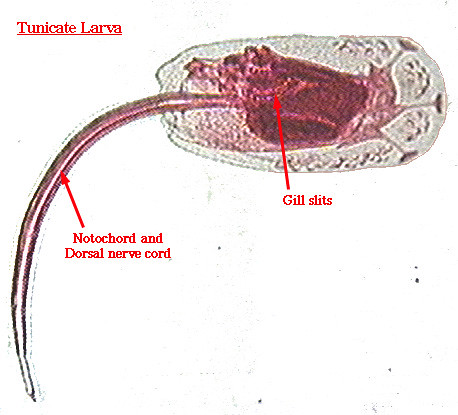Inspired by Quixote's excellent post about ascidians--my firstest study organism EVAH--I've decided to delve into the archives and repost something of my own about ascidians.
I used to study botrylloid ascidians (Botrylloides diegensis to be exact). Ascidians are one of our closest invertebrate relatives. In their larval stage, they look like little tadpoles and even have a notochord (picture taken from here):

Within a few hours, the tadpole settles on a flat surface, and resorbs its tail, and essentially turns itself into a giant pair of vocal chords that are wrapped in mucus. The whole structure is covered with a tunic, that has an inflow tube and an outflow siphon. It then filters food out of the water (look at the top critter; it's about 4mm in diameter; taken from here):

Those little orange bulbs around the edges of the colony are the ampullae, which are involved in circulation (they're kind of like hearts). A complete aside: ascidians use vanadium in their blood pigment (vanadium is toxic to most organisms). Back to our original programming... If it's a colonial ascidian (and botrylloids are colonial), it begins budding off more siphons (look at the bottom colony above). Eventually, it grow into a nice big colony that looks like this (taken from here):

On the East Coast, Botrylloides diegensis is an invasive marine species; I've personally seen habitats in Maine where they've been so successful that all the native filter feeding species have been driven into refuge habitats, such as the underside of kelp fronds. One of the cool things about botrylloid ascidians is that genetically distinct colonies can fuse... but I'll talk about that next week (and hopefully, I'll be able to dig up some old photos).
Here's what a colorful relative (unknown species) looks like (taken from here):


This botryllid is Botrylloides violaceus, not B. diegensis. And there is no B. diegensis on the east coast; it's B. violaceus. The most distinguishing character is the huge tadpole with 24-32 lateral ampullae, clearly seen in the newly settled juvenile in your photo. It's not actually budding new siphons but whole zooids. When the tadpole settles it already has the 2 buds. Your photo is a very nice one of 2 newly settled individuals. Botrylloides violaceus is native to Japan and has been introduced to both coasts of the U.S.
Glad you like my lab's pictures! Those were actually from a workshop that Gretchen led at the Bodega Marine Lab a few years back. The botryllid situation on the west coast is actually pretty interesting. B. diegensis is native here, and B. violaceous has invaded. The two seem to coexist. We also have a third Botrylloides species that a variety of us have noticed, but no one has yet confidently identified. It's a mystery! That, and we have a good bit of non-native Botryllus schlosseri (always so pretty with it's rosettes of zooids!) Actually, right now, the botryllids are settling like crazy! It's that time of year!
Interesting blog. I have a colony of these that is living in my salt aquarium that are very interesting. I cannot find a picture of them on the web and would like some help identifying what they are. I think the rock they are living on came from Fiji but cannot be sure. If you email me Ill send you a picture.
I have a colony of this growing also.. been trying to figure out what I should do with it... from reading about it on different websites it seems to be an invasive species for the coastlines??
thanks.